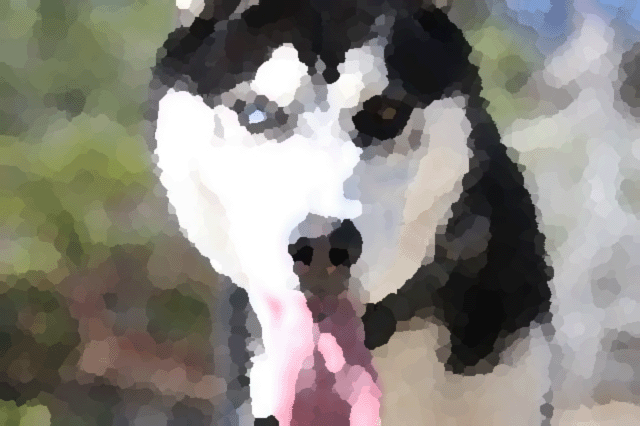First off, I am faaar from being an expert on dogsleds but
I did do some research and have learned a thing or two from reading up on
them and talking to other people so I will just share with you what I know.
It might be best if I give you a description and details of my sled and from
there, you can learn more about other dogsleds on the market and make an
informed decision. And please, others chime in with your own opinions/info
and feel free to make corrections.
BTW, my first dogsled driving experience was back in February at Shaver Lake
with Niko and Lyka at wheel and two of Hugo's dogs, QT and Sitka, taking me
on a hell of a ride for 6 miles on a borrowed sled that Nichole was gracious
enough to loan me.
Below are pics of Nichole's sled:
That is a basket style sled, made by a company called "Affordable Dog
Sleds". Why? Because they are affordable. You do have to assemble them
yourself but the fact that they send them to you as kits saves you ALOT on
shipping costs. If I am not mistaken, Sheryl also has one of these sleds.
By the time I made it back to Shaver Lake at the end of March, I had
purchased a used beginner sled that was originally made by Arctic Star. I
got a great deal on it as it was only 4 years old and only occasionally used
by a retired doctor with his two huskies. It was in great condition and was
definitely worth the 4-hour drive to San Luis Obispo to pick it up (much
better than paying over $200 for shipping costs when sleds are trucked over
from the East Coast).
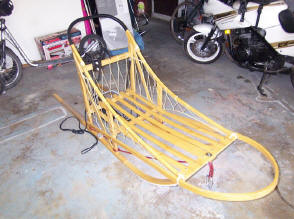 |
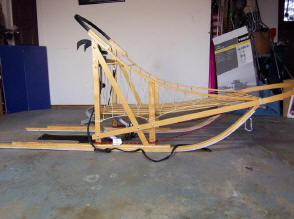 |
My sled has six-foot runners (similar to skis, this makes it easier to
handle than sleds with 7 or 8 foot runners but won't go as fast), has a 44"
basket, and the handlebar height is 37" high. It is a two- stanchion sled.
The stanchions are the vertical wood slats that connect to the runners and
hold up the basket to the main frame of the sled. I corresponded with Johnn
Molburg, who originally handcrafted the sled and he told me that this sled
was NOT designed to take in adult passengers so he recommends 50, maybe a
100 lbs on it. However, I have taken on a couple of adult passengers on it
for short rides.
Note: From my observations, basket sleds with bigger beds end up having
three stanchions (or more). OR, sleds that can take heavier loads have 3
stanchions --- makes sense since this is what supports the bed. Most SPRINT
racing sleds have smaller baskets (sometimes, only a half basket) and two
stanchions to make them as lightweight as possible. FYI, I think my sled
weighs about 30 lbs.
My sled is mostly a bolted sled but is tied/lashed at the brush bow and at
the handlebar joints for added flexibility. Generally, tied sleds are more
flexible (and also more expensive). The previous owner also purchased it
with a tied basket (the thin pieces of rope crisscrossing the sides of the
sled basket) which gives you a little bit of containment when transporting
gear in the basket and more of an "old school look". It also came with a
bridle (rope tied to the stanchions that go to the bottom of the bow), to
which you would attach your dog sled team.
WHAT ABOUT BRAKES? DON"T I NEED BRAKES?
Brakes are a musher's best friend (after his sled dogs, that is). I have
three different braking systems on my sled, all of which I either upgraded
or added on. They are the double-claw (aka bar) brake, the drag mat, and the
dreaded snow hook.
The bar brake is permanently attached to the sled --- I upgraded this from a
single claw brake system. Knowing that I would be using this sled with 3 or
more (have ran up to 6) dogs, I realized that I needed something with much
more braking power so I spent $50 and installed the double-claw system. Here
is a pic of what the single claw brake looked like --- you can see why I
upgraded:
|
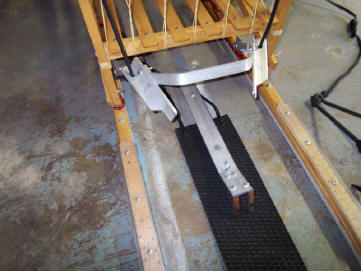
|
The drag mat is basically a rectangular piece of conveyor belt or a portion
of a snow mobile track. It is lightweight and drags along the snow (or I can
hook it to below the handlebar so it's hanging from the back of the sled ---
more expensive models have a spring system that flips up) and is attached
via rope to the stanchions. I added this on as well as it is a great way to
smoothly slow down the sled by simply stepping on and applying your weight
to the mat. You don't have to have a drag mat --- the first time I went
sledding, I was using my feet.
The third component to stopping a sled is the snow hook. This is something
you purchase separately and come in different weights, depending on how
large your team is. Think of the snow hook as your hand brake or emergency
brake --- you use it to hold your team in place when you are off the sled or
to use as an emergency anchor to stop a runaway sled (and yes, I know this
from personal experience). They even have lightweight hooks just for keeping
your lead dogs in place or for a two dog team (as for when using a kick
sled) and they call this a leader hook. The main snow hook is connected via
a line that is attached to the end of your gangline. FYI, mushers sometimes
carry two snow hooks for much larger teams. Oh yeah, there is a fourth
braking component --- me! If I fall off the runners and/or the sled tips
over, I make sure to grab on to the handlebars and not let go. In which case
my butt, hips, shoulders, legs, even my face, ends up being a braking system
but sometimes this is a better option to having to track down a runaway sled
dog team out in the woods.
I do want to mention that there is a component/accessory called a snub line
that I also use. This is NOT a braking system but rather another method to
help keep the sled in place while hooking up a dog team or while taking a
longer rest stop. It is simply a long piece of rope (such as you would use
for your center line), one end of which is attached to the end of the
gangline. The other end can then be looped around a (very) stable stationary
object such as a tree or a truck via a quick release mechanism.
WHAT'S A QCR?
Sleds come with plastic runner bases attached to the bottom surface of the
sled, and this is what enables them to glide over the snow. The standard
runners (such as what I have on mine) that you find on beginner's sled or
recreational sleds are made of UHMW (Ultra High Molecular Weight) plastic
which are screwed on to the base of the sled. These are made from high
density plastic that has a higher resistance to abrasion. However, most
racing and long distance sleds nowadays come with a QCR system, which stands
for Quick Change Runners. Instead of screwing on the runners directly to the
wood, rails are attached to the base and then you can replace your runners
by simply sliding it out and changing it with a new one (BTW, from what I
understand, sliding the plastic runners in and out of the rails is not as
"quick change" as one would be led to believe).
Why would you replace your runners? I, for one, need to do so as we went
through some rough terrain (as in running over bare asphalt) this past
season so I've got gouges and pockmarks on the bottom of my runners.
Competitive mushers though may be replacing their runner bases with a
different type of plastic when they are racing. The standard UHMW runners is
what they will probably be using for training purposes but come race time,
they may switch to a type that is not as heavy duty but allows for a
smoother (ergo, faster) glide over the snow. Which is why a QCR system makes
it more convenient.
BASKET STYLE vs. TOBOGGAN STYLE --- WHAT SHOULD I GET?
A toboggan style sled is essentially the same as a basket style sled except
for the bed. Whereas the basket sled uses wood slats for its bed, the
toboggan sled uses a hard plastic bed. AND, whereas the basket sled has a
raised bed, the toboggan sled is connected directly to the runners which
means that it is down at snow level and is also used to glide over the snow.
Below is a picture of the Hugo's toboggan sled:
|
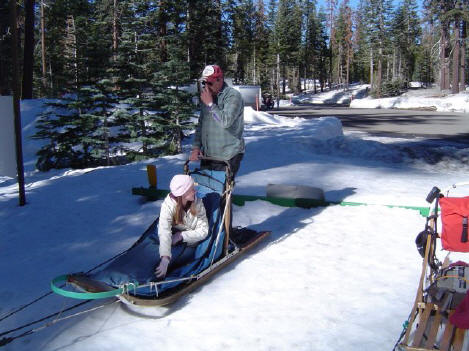
|
Toboggan sleds can generally take in heavier loads and are built to take
much more abuse than basket sleds. These are used for freighting, touring,
and for mid and long distance races. The sled in the picture is
"accessorized" with a sled bag for keeping passengers warm and/or storage
for supplies. Sled bags (along with certain supplies and equipment) are
required accessories for mid and long distance races.
So the type of sled you will get will depend on the type of sledding you
want to do. Basket sleds are more for recreational, sprint racing, and/or
smaller dog teams (probably 2 -8, however, note that there are heavy duty
touring basket sleds made with much longer beds or use in dog sled tours
and/or long distance races). These are also easier to pull as they are
usually lighter in weight than toboggan sleds. And they perform better on
groomed surfaces or packed snow than a toboggan sled would, which has a
bigger snow surface contact area. On the other hand, a toboggan sled would
float better on fresh snow or ungroomed trails. It is also good for
recreational sledding as well as for use with smaller dog teams but would be
able to take the abuse of running bigger teams and heavier loads.
OKAY, I WANT A SLED --- WHERE DO I BUY ONE?
Unfortunately, we have no local sled makers (that I know of) here in
Southern California. Most of them are in the East Coast, such as
Arctic Star which is in Pennsylvania or
Maine Made Sleds to mention a few of those that are probably more within the price range of
the recreational musher or want to-be-sprint-racers like us. Brand new sleds
can cost anywhere from $250 to $700 dollars for urban mushing use BUT on top
of that, the cost of shipping is what is makes it hard to swallow. It can
cost $200 or more when shipping a fully assembled sled from the east coast.
Of course, as mentioned earlier, you can save a ton on shipping if you are
willing to assemble the sled yourself by buying from
Affordable Dog Sleds.
There is also Adanac Sleds
which is also a reputable traditional dog sled maker and they are not too
far away -- they are based out of Montana and you can buy a "kit" sled from
them. They sell both a basket and toboggan sled that they ship out in two
parts, so it is already partially assembled. I inquired last year about
shipping costs for these kit sleds and they quoted me approximately $65.
Note that these kit sleds are not as big as your full size standard sled and
would definitely be good for even a 2-dog team. BTW, they do also sell the
standard sized basket and toboggan sleds. FYI, Jack and Pam Beckstrom are
the owners/operators of Adanac Sleds and are both very helpful and
informative people. Be aware though that they do get a lot of sled orders so
you may have to wait for weeks before they can ship out a sled. Also closer
to home as sources for dog sleds would be
Alpine Outfitters and
Nordkyn Outfitters,
both based out of Washington State. All their sleds are shipped completely
assembled and I do not know how much shipping costs are but it is probably
cheaper than shipping out from the East Coast. Or you can always drive out
there to pick it up.
Here is a list of other sled makers that you can at least look at and
compare products and pricing on:
http://www.sleddogcentral.com/equip_sleds.htm
|
